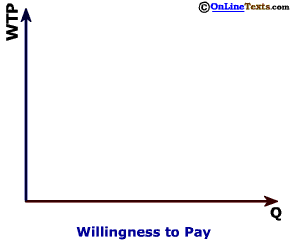
In order to understand Willingness to pay17 we must view the demand relationship from a new perspective. Typically, when working with demand, we take market price as the independent or explanatory variable and take desired quantity demanded as the dependent variable. Given a price, the demand relationship tells us how much a consumer would like to purchase at that price. Willingness to pay simply reverses that perspective.
To the right we show a demand curve as always, but in this case we've labeled the vertical axis WTP (willingness to pay) rather than price. In every other respect, this is a normal demand curve. Any demand curve can be viewed in this way. From this demand curve we can see that if 40 units of the good were available for purchase, or if the consumer had already consumed 40 units, her willingness to pay for an additional unit would be 2. Another way to think of this is that if 40 units had already been purchased, the value to her of one more unit would be 2. If only 25 units were available our consumer's willingness to pay would rise to 6, and if only 5 units were available our consumer's willingness to pay would be 12.
The relationship between willingness to pay and quantity is an inverse relationship, as we would expect. The less of the good that is available, or that has been consumed, the more the consumer is willing to pay for an added unit, or the greater value the consumer places on an additional unit. This new way of looking at the demand curve will be important in understanding price ceilings, price floors and rationing.


We will consider willingness to pay in more detail in Chapter 4. Consumer Choice.